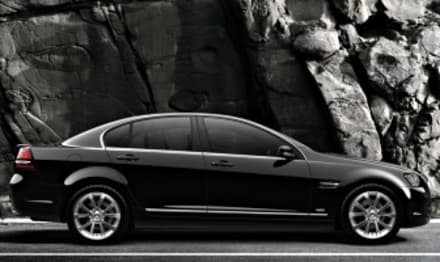
Holden Calais 2009 Review
- Holden Calais
- Holden Calais 2009
- Holden Calais Reviews
- Holden Reviews
- Holden Sedan Range
- Sedan
- Holden
- Family Cars
Back in the hairy-chested days of motoring, real men drove V8s; fuel was aplenty and a greenie was someone adept at growing spuds and peas in the back garden. But then the glory days came to an end. Fuel supplies are under threat, Greenies have become our social conscience and anyone driving a V8 is considered, by some, as being akin to an eco terrorist.
We are told by those smugly behind the wheel of their hybrids that big V8s suck fuel; fuel is precious, therefore the muscle car is doomed. Or is it? Reports of its impending death are premature — in fact there was been a resurgence in V8 sales of late.
That is due in part to car companies getting clever in the way they have got around the V8-so-it-must-be-thirsty problem. The answer is to turn a V8 into a V4 when all that power is not needed — and let's face it most V8s run well under a full load for most of the time.
Shutting down cylinders is not a new idea but up until now there wasn't the affordable technology available to make the system work smoothly and reliably. The advancement of computers solved that problem, with General Motors leading the way in 1981.
Today, companies like Honda (Variable Cylinder Management) and Chrysler (Multi-Displacement System) have joined the bandwagon, deactivating part of an engine when full power is not needed. Honda's Accord V6, for example, can happily run on all six, four or even three cylinders depending on engine load.
Switching off cylinders means potential savings in fuel consumption and more importantly, reduced greenhouse nasties at the exhaust pipe.
AFM drivetrain and fuel consumption
Holden has taken up the technology, offering its Active Fuel Management (AFM) system on all its automatic V8 models. Does it save a bucket load of money in lower running costs? The short answer is no, but there are savings to be made if you drive smoothly and wisely.
I've been behind the wheel of Holden's impressive 6.0-litre Calais V, a car which can give its European rivals a run for their money in the prestige market. After three days of a mix of city and highway running, the V8 averaged a remarkable 11.1l/100km. By the end of the week and more city use, the consumption readout had slipped to 13.4l/100km, peaking at 14.6l/100km after all concept of driving with any frugality in mind went out the window. Holden says AFM can reduce fuel consumption by a litre per 100km, with the Calais' official fuel consumption rated at 12.9l/100km.
But the AFM system can be a little odd at times. For example, sitting stationary at the traffic lights the engine, under no load, runs on all eight cylinders. You have to ask why? Plant your foot and the V8 does spring into life, but it lacks the satisfying raw V8 growl of a beast under the bonnet. It's more refined than that and very much in keeping with the car itself.
It's hard to pick when the V8 shuts down half its cylinders (numbers 1,4,6 and 7) and runs as a four; the change is smooth. You can keep an eye on what's happening thanks to a readout in the instrument panel which tells you when all eight or just four pots are firing and what the instant fuel consumption is, so it becomes a bit of a party game to try and get the best readout possible.
Holden says full V8 power is restored within a claimed 20 milliseconds when acceleration is needed. The bad news is that AFM robs the standard V8 engine of 10kW of power and 13Nm of torque, but the AFM's 260kW is still rewarding.
Price and fitout
The Calais V sells for $60,990 plus on-road costs but Holden recently launched a 60th anniversary model with a bit more bling for $63,290 — if you can find one.
The Calais is a big, comfortable family car with a bright and airy cabin and good storage space. It already packs a lot of safeties and feel-good bling anyway including six airbags, traction and stability control, dual-zone climate air conditioning, comprehensive digital dashboard display, ceiling mounted DVD player with cordless headphones for backseat passengers, quality sound system, leather upholstery, power adjustable front seats, park sensors and auto wipers and headlamps. The test car came fitted with optional satellite navigation and sunroof.
Dislikes
The A pillar is too heavy and blocks vision, the handbrake is a finger pinching disaster of design, the rear seats don't fully split, only leaving a small ski hatch to the boot and there are too many warning beeps and buzzers to remind you to put you seatbelt on, when you select reverse and when you go back to drive.
The bottom line
You can have a V8 and display a paler shade of green. If you need the power of a V8, especially for towing, then the AFM version of the Calais makes sense.
Holden Calais V AFM
Price: from $60,990
Engine: 6-litre V8 with Active Fuel Management
Power: 260kW, 517Nm; CO2 329g/km
Fuel consumption: 12.9l/100km claimed
Transmission: Six-speed sequential auto with manual shift if required
Pricing guides
Range and Specs
| Vehicle | Specs | Price* | |
|---|---|---|---|
| V | 6.0L, PULP, 6 SP AUTO | $15,950 – 20,460 | 2009 Holden Calais 2009 V Pricing and Specs |
| (base) | 3.6L, ULP, 6 SP AUTO | $10,120 – 13,860 | 2009 Holden Calais 2009 (base) Pricing and Specs |
| V | 6.0L, PULP, 6 SP AUTO | $15,400 – 19,800 | 2009 Holden Calais 2009 V Pricing and Specs |
| V 60th Anniversary | 3.6L, ULP, 5 SP AUTO | $14,410 – 18,920 | 2009 Holden Calais 2009 V 60th Anniversary Pricing and Specs |
$6,999
Lowest price, based on 13 car listings in the last 6 months














